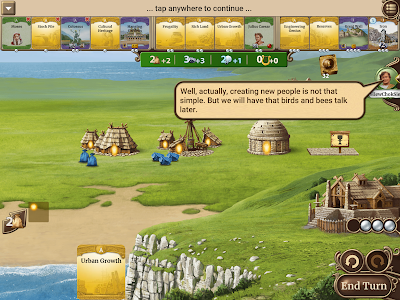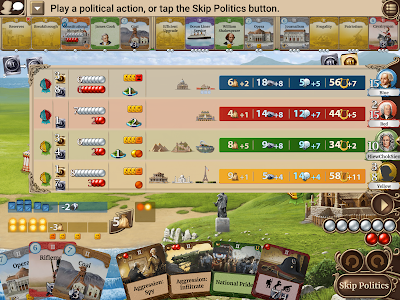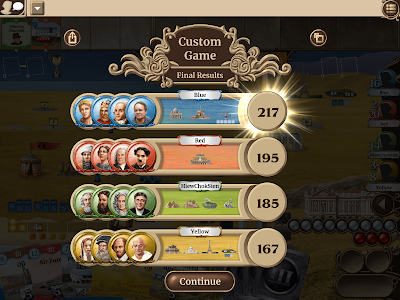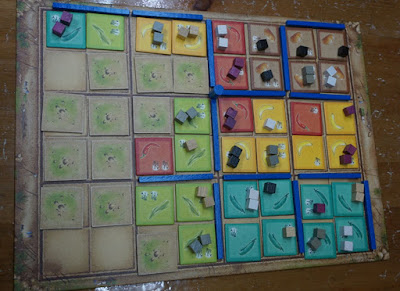Plays: 5Px1.
The Game
All Manor of Evil is a H. P. Lovecraft themed game. The setting is an old, mysterious and ill-omened mansion. It's not a good place, but it has lots of treasures, and that's why you are here. Players are treasure hunters, i.e. thieves, here to steal treasures. Whoever leaves with the most valuable loot wins the game. There is a twist though. Being in this manor drives people crazy. Whoever accumulates the most insanity points by game end immediately goes nuts and loses. Only the sane people, or I should say not-completely-crazy people, get to compare score to see who wins. There is one more twist. There is another way the game can end. Players' actions may awaken one of the three elder gods. If that happens, you get something bad, e.g. someone, or someones die. Only after that you check for who goes crazy, and if there are still people left, you compare treasures.
The game board is small, and is used only to place the treasure cards. What you see on the game board are the rooms in the manor. Each room has one treasure, and everyone can see what the treasure is. The number in the purple circle is the insanity points, and the number in the gold circle is the victory points. When you steal a treasure, you put it in a stack before you. Nobody is allowed to examine the stack, even yourself. Only the top card is visible to everyone. Some treasure cards have text. These are effects which are resolved when the treasure is being stolen.
The core game mechanism is simultaneous action selection. Everyone has this same set of four action cards. Each action card has a number, a special power, and the names of two rooms. The two rooms mean you get to steal a treasure from one of them when your turn comes. Every round everybody secretly picks one card to play, and once everyone is ready, all the selected cards are revealed simultaneously. Players who happen to pick the same action card all get one insanity token. Then you execute actions in order of the action card number. If two players have picked the same action card, priority depends on who the start player is for the round. This start player changes every round.
You may not use the same action card back-to-back. From Round 2 onwards, you only have 3 cards to pick from. This means it is slightly easier to guess what cards your opponents will play. For each of them, you know there is one card they cannot pick. The card special powers are: adding an insanity token to a room, discarding 3 insanity tokens, stealing the top card from the deck if it is a treasure, and swapping your top treasure card with a treasure in one of the rooms.
Before the game starts, you draw two character cards then pick one. I picked the witch, which meant I must make the game end by summoning an older god. Otherwise I would automatically lose.
There are always three elder gods per game - a blue type, a green type and a yellow type. They are randomly drawn before the game starts. They are two sided, with different behaviours, and some actions cause them to flip. In our game, the blue elder god if summoned would trigger another random elder god. The green elder god would kill everyone who doesn't have a rite (a type of treasure). The yellow elder god would kill the person with the most lapis lazuli.
The purple tokens on the three elder gods are the summon tokens. An elder god is summoned when there are six tokens. However this is checked only at the end of a round. During a round, it is possible for one player to place a sixth token, only later to have it removed by another player, leaving five. In such a case, the elder god is not yet summoned. It is possible that two elder gods both have six tokens. If this happens, the world ends and everybody loses.
The Play
The basic premise of the game is collecting treasures while avoiding insanity. You want to go for high valued treasures, because that's more efficient, but you may also go quantity over quality, which is probably viable too. You don't exactly need to minimise your insanity, you just need to make sure you are not the craziest. We have seen a similar mechanism before in Sobek. I'm sure there are other examples. As I played the game, I realised that this basic premise is just that - a basic premise. There is more to it. In fact it feels like a tiebreaker. There are many ways to die in this game. If you are able to get the richest guy killed, it doesn't matter how rich he is. If you manage to kill or drive insane everyone else, you don't even need to care how many treasures you collect. The secret player characters are important. So are the three elder gods. They set the stage for competition and they determine how you need to play to get your opponents eliminated. In our game, Kareem's character removed his insanity points if he could summon the yellow or green elder god. So he could go nuts during the game as long as he could summon one of these elder gods. Another character doubled your points. That had a big impact.
Our game evolved into an election game, with some supporting the blue elder god and some supporting the green elder god. This happened mainly because Kareem was obviously trying to summon the green elder god. Dennis supported him. The rest of us were alarmed and decided to all vote for blue elder god. I secretly needed to summon any elder god in order not to lose, so blue worked for me. It felt impossible for a game to last till the second clock card, which was near the bottom of the deck. Perhaps our game was an anomaly, since multiple people had incentives to summon an elder god.
We had to fight for valuable treasures, or treasures with nifty powers. Who the start player was was an important consideration when we picked action cards. We often tried to force people to take more insanity tokens by placing the tokens onto attractive treasures. It was important to see which action cards the opponents wouldn't be allowed to pick for the round, and plan accordingly. We had 5 players, and that meant at least two players would clash, because action cards number 1 to 4.
It was difficult to try to remember who had collected how many insanity points (on the cards) and victory points. I couldn't even quite remember how many I had. I was not allowed to check my stack.
Our game ended with Dennis happily summoning a second elder god, causing armageddon. He knew he couldn't win, so he decided to have everyone die. Mission accomplished!
The Thoughts
All Manor of Evil is a game with much hidden information. Your identity is initially secret. As everyone collects treasures, the information is hidden and it is difficult to keep track. The action selection mechanism means there is much double guessing. The three elder gods is public information. They set the stage. During play you try to work out the identities of your opponents, or at least try to deduce what they are trying to achieve. The elder gods and the identities are important factors that get people killed before the final reckoning.
I find the game complexity in an awkward situation. I feel this should be a light game, but it plays like a medium weight game, because there is a lot of text to read, and powers to remember and consider - the elder gods, the characters, the action cards, the treasures. This makes me a little impatient. Maybe it's because I'm not specifically a Lovecraft fan, and the setting doesn't specifically draw me in.
































































